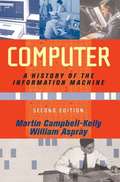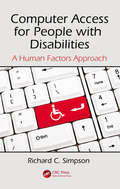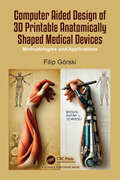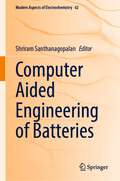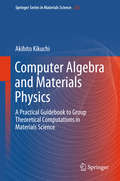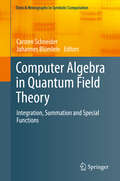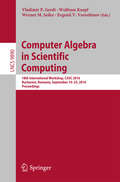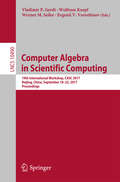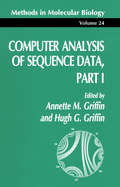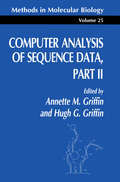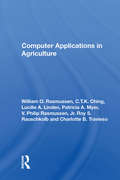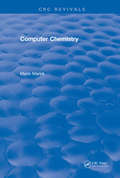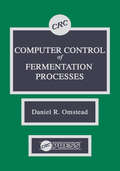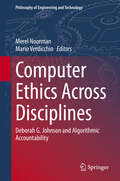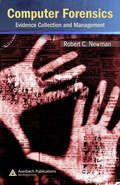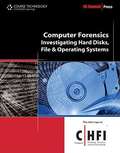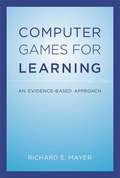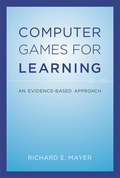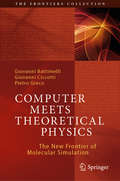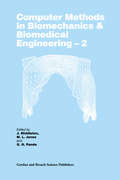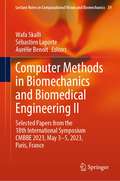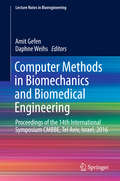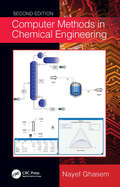- Table View
- List View
Computer
by Martin Campbell-Kelly William AsprayCampbell-Kelly (University of Warwick) and Aspray (Indiana University) describe the way computing was handled before the arrival of electronic computers, and recount the development of the mainframe computer. They review the origins of office machinery, early failed attempts to build a calculating engine, scientific war programs, the IBM system/360 family of computers, and the importance of real time for common commercial applications. The second edition expands the later sections on CD-ROMs, the internet, and web commerce. Annotation ©2004 Book News, Inc. , Portland, OR (booknews. com)
Computer
by Martin Campbell-Kelly William AsprayComputer: A History of the Information Machine, Second Edition traces the story of the computer, and shows how business and government were the first to explore its unlimited, information-processing potential. Old-fashioned entrepreneurship combined with scientific know-how inspired now famous computer engineers to create the technology that became IBM. Wartime needs drove the giant ENIAC, the first fully electronic computer. Later, the PC enabled modes of computing that liberated people from room-sized, mainframe computers. This second edition now extends beyond the development of Microsoft Windows and the Internet, to include open source operating systems like Linux, and the rise again and fall and potential rise of the dot.com industries.
Computer Access for People with Disabilities: A Human Factors Approach (Rehabilitation Science in Practice Series)
by Richard C. SimpsonIncorporating Compass Computer Access Assessment software, Computer Access for People with Disabilities: A Human Factors Approach provides the information clinicians need to know in order to provide effective alternative computer access solutions to individuals with disabilities. This book presents technology for individuals with physical, cognitive, and sensory impairments, and for older adults. The text covers text entry devices, pointing devices, switch access, automatic speech recognition, and web accessibility. The book draws on research from the fields of rehabilitation engineering, occupational therapy, and human-computer interaction (HCI) and emphasizes fundamental concepts and principles that remain true regardless of which specific operating system or product is being used.
Computer Aided Design of 3D Printable Anatomically Shaped Medical Devices: Methodologies and Applications
by Filip Gorski"Computer Aided Design of 3D Printable Anatomically Shaped Medical Devices: Methodologies and Applications" presents a comprehensive framework for designing 3D printable medical devices tailored to individual anatomies. Bridging engineering and medicine, the book guides readers through advanced CAD techniques, anatomical data acquisition (via 3D scanning and imaging), and additive manufacturing processes, presenting mostly results of author's own and co-authored research. Emphasizing efficiency, customization, and real-world applications, it showcases methodologies developed in collaboration with medical professionals for orthopedic devices, surgical aids, and prosthetics. Case studies offer insights into practical uses, demonstrating how these innovations enhance patient care and surgical outcomes through personalized, accessible solutions.
Computer Aided Engineering of Batteries (Modern Aspects of Electrochemistry #62)
by Shriram SanthanagopalanThis edited volume, with contributions from the Computer Aided Engineering for Batteries (CAEBAT) program, provides firsthand insights into nuances of implementing battery models in actual geometries. It discusses practical examples and gaps in our understanding, while reviewing in depth the theoretical background and algorithms. Over the last ten years, several world-class academics, automotive original equipment manufacturers (OEMs), battery cell manufacturers and software developers worked together under an effort initiated by the U.S. Department of Energy to develop mature, validated modeling tools to simulate design, performance, safety and life of automotive batteries. Until recently, battery modeling was a niche focus area with a relatively small number of experts. This book opens up the research topic for a broader audience from industry and academia alike. It is a valuable resource for anyone who works on battery engineering but has limited hands-on experience with coding.
Computer Aided Pharmaceutics and Drug Delivery: An Application Guide for Students and Researchers of Pharmaceutical Sciences
by Vikas Anand SaharanThis book examines the role of computer-assisted techniques for discovering, designing, optimizing and manufacturing new, effective, and safe pharmaceutical formulations and drug delivery systems. The book discusses computational approaches, statistical modeling and molecular modeling for the development and safe delivery of drugs in humans. The application of concepts of QbD (Quality by Design), DoE (Design of Experiments), artificial intelligence and in silico pharmacokinetic assessment/simulation have been made a lot easier with the help of commercial software and expert systems. This title provides in-depth knowledge of such useful software with illustrations from the latest researches. The book also fills in the gap between pharmaceutics and molecular modeling at micro, meso and maro scale by covering topics such as advancements in computer-aided Drug Design (CADD), drug-polymer interactions in drug delivery systems, molecular modeling of nanoparticles and pharmaceutics/bioinformatics. This book provides abundant applications of computers in formulation designing and characterization are provided as examples, case studies and illustrations. Short reviews of software, databases and expert systems have also been added to culminate the interest of readers for novel applications in formulation development and drug delivery. Computer-aided pharmaceutics and drug delivery is an authoritative reference source for all the latest scholarly update on emerging developments in computed assisted techniques for drug designing and development. The book is ideally designed for pharmacists, medical practitioners, students and researchers.
Computer Algebra and Materials Physics: A Practical Guidebook to Group Theoretical Computations in Materials Science (Springer Series in Materials Science #272)
by Akihito KikuchiThis book is intended as an introductory lecture in material physics, in which the modern computational group theory and the electronic structure calculation are in collaboration.The first part explains how to use computer algebra for applications in solid-state simulation, based on the GAP computer algebra package. Computer algebra enables us to easily obtain various group theoretical properties, such as the representations, character tables, and subgroups. Furthermore it offers a new perspective on material design, which could be executed in a mathematically rigorous and systematic way.The second part then analyzes the relation between the structural symmetry and the electronic structure in C60 (as an example of a system without periodicity). The principal object of the study was to illustrate the hierarchical change in the quantum-physical properties of the molecule, which correlates to the reduction in the symmetry (as it descends down in the ladder of subgroups).The book also presents the computation of the vibrational modes of the C60 by means of the computer algebra. In order to serve the common interests of researchers, the details of the computations (the required initial data and the small programs developed for the purpose) are explained in as much detail as possible.
Computer Algebra in Quantum Field Theory: Integration, Summation and Special Functions (Texts & Monographs in Symbolic Computation)
by Carsten Schneider Johannes BlümleinThe book focuses on advanced computer algebra methods and special functions that have striking applications in the context of quantum field theory. It presents the state of the art and new methods for (infinite) multiple sums, multiple integrals, in particular Feynman integrals, difference and differential equations in the format of survey articles. The presented techniques emerge from interdisciplinary fields: mathematics, computer science and theoretical physics; the articles are written by mathematicians and physicists with the goal that both groups can learn from the other field, including most recent developments. Besides that, the collection of articles also serves as an up-to-date handbook of available algorithms/software that are commonly used or might be useful in the fields of mathematics, physics or other sciences.
Computer Algebra in Scientific Computing: 18th International Workshop, CASC 2016, Bucharest, Romania, September 19-23, 2016, Proceedings (Lecture Notes in Computer Science #9890)
by Wolfram Koepf Vladimir P. Gerdt Werner M. Seiler Evgenii V. VorozhtsovThe book covers various topics of computer algebra methods, algorithms and software applied to scientific computing. One of the important topics of the book is the application of computer algebra methods for the development of new efficient analytic and numerical solvers, both for ordinary and partial differential equations. A specific feature of the book is a detailed analysis of the advanced software systems like Mathematica, Maple etc. from the viewpoint of their applicability for the solution of scientific computing problems. The book will be useful for researchers and engineers who apply the advanced computer algebra methods for the solution of their tasks.
Computer Algebra in Scientific Computing: 19th International Workshop, CASC 2017, Beijing, China, September 18-22, 2017, Proceedings (Lecture Notes in Computer Science #10490)
by Wolfram Koepf Vladimir P. Gerdt Werner M. Seiler Evgenii V. VorozhtsovThe book covers various topics of computer algebra methods, algorithms and software applied to scientific computing. One of the important topics of the book is the application of computer algebra methods for the development of new efficient analytic and numerical solvers, both for ordinary and partial differential equations. A specific feature of the book is a detailed analysis of the advanced software systems like Mathematica, Maple etc. from the viewpoint of their applicability for the solution of scientific computing problems. The book will be useful for researchers and engineers who apply the advanced computer algebra methods for the solution of their tasks.
Computer Analysis of Sequence Data, Part I (Methods in Molecular Biology #24)
by Annette M. Griffin Hugh G. GriffinThese comprehensive, up-to-date handbooks are designed for those scientists engaged in the computer analysis of sequence data who want hands-on help in using the most important commercial software available, but simply do not have the time to become computer experts. The expert authors guide you through the programs with easy-to-follow, step-by-step instructions. The topics covered include translations of sequences, sequence alignment, phylogenetic trees, analysis of RNA secondary structure, database searching, submission of data to EMBL/GenBank/DDBJ/etc., maintaining sequence projects, and using patterns to analyze protein sequences. Many chapters have been written by world-class authorities in the field, among them R. Staden, M. Gribskov, D. Higgins, W. Pearson, M. Zuker, and G. Barton. Each volume shares five essential chapters concerning the analysis of sequence data, the FASTA program, converting between sequence formats, obtaining software via INTERNET, and the submission of nucleotide sequence data. Part I covers GCG, MicroGenie, PC/GENE, and FASTA programs. Part II covers Staden and Staden Plus, DNA Strider, FASTA, and MacVector programs.
Computer Analysis of Sequence Data, Part II (Methods in Molecular Biology #25)
by Annette M. Griffin Hugh G. GriffinThese comprehensive, up-to-date handbooks are designed for those scientists engaged in the computer analysis of sequence data who want hands-on help in using the most important commercial software available, but simply do not have the time to become computer experts. The expert authors guide you through the programs with easy-to-follow, step-by-step instructions. The topics covered include translations of sequences, sequence alignment, phylogenetic trees, analysis of RNA secondary structure, database searching, submission of data to EMBL/GenBank/DDBJ/etc., maintaining sequence projects, and using patterns to analyze protein sequences. Many chapters have been written by world-class authorities in the field, among them R. Staden, M. Gribskov, D. Higgins, W. Pearson, M. Zuker, and G. Barton. Each volume shares five essential chapters concerning the analysis of sequence data, the FASTA program, converting between sequence formats, obtaining software via INTERNET, and the submission of nucleotide sequence data. Part I covers GCG, MicroGenie, PC/GENE, and FASTA programs. Part II covers Staden and Staden Plus, DNA Strider, FASTA, and MacVector programs.
Computer Applications In Agriculture
by William Otto RasmussenU.S. agriculture appears to be at a major turning point in terms of technological change and innovation as it enters the information age[1]and at the heart of the information revolution is the microcomputer. This handbook explains in practical terms how computers are being used in agriculture and analyzes some of the issues surrounding present and potential computer applications. The authors define agriculture in the broadest possible terms, including the traditional aspects of farming, the industries supporting agriculture, service bureaus related to agriculture, classroom instruction and youth development, and the rural family and community. Considered are specific ways microcomputers are changing agriculture, the exact nature of these changes, and how agriculturists are currently adapting microprocessor technology to make agriculture more efficient and viable. Also included is a discussion of the computer software and hardware used in agriculture today, hardware and software purchasing strategies for both individuals and institutions, and sources of information on computer applications in agriculture.
Computer Chemistry (CRC Press Revivals)
by Mario MarsiliComputer Chemistry illustrates the methods and philosophies of how a computer can be instructed to "understand" chemical facts, formulas and rules. It focuses on discussions of all of the major sections in both theoretical framework and practical application through examples. It includes the Synthesis Design Systems for the simulation of chemical reactions, the Structure Elucidation Systems for the interpretation of spectral data, the Molecular Modelling Systems for the visualization of chemical structures and the calculation of physico-chemical parameters.
Computer Control of Fermentation Processes
by Daniel R. OmsteadThe purpose of this volume is to describe the components, assembly, and implementation of computer-based process control systems. Presented in two sections, it illustrates how such systems have been used to monitor and control industrial fermentation processes as a means to improve our understanding of product biosynthesis. This book covers the fields of indirect parameter estimation and fermentation-specific control algorithms. It also includes chapters which describe system architecture and process application, process control, on-line liquid sampling and computer system architecture. This is an ideal source for anyone involved with biotechnology, bioengineering, microbial technology, chemical engineering, and computer control.
Computer Ethics Across Disciplines: Deborah G. Johnson and Algorithmic Accountability (Philosophy of Engineering and Technology #44)
by Merel Noorman Mario VerdicchioThis edited volume brings together philosophers and scholars in disparate fields who have engaged in Professor Deborah G. Johnson’s body of work throughout her long career. It appeals to both students and researchers and introduces Johnson’s thought to a broader audience. This text shows how with due to the resurgence of AI research, her work is more relevant than ever. The volume will help a new generation of scholars benefit from the conceptual insights that Johnson has provided. Her work on algorithmic accountability sets the tone in particular. Chapters illustrate how combining philosophy of technology across disciplines helps clarify the complex intricacies of AI and societies, in particular the topic of accountability. Other themes covered include moral agency and responsibility, transparency, gender and technology as well as ethics education.
Computer Forensics: Evidence Collection and Management
by Robert C. NewmanComputer Forensics: Evidence Collection and Management examines cyber-crime, E-commerce, and Internet activities that could be used to exploit the Internet, computers, and electronic devices. The book focuses on the numerous vulnerabilities and threats that are inherent on the Internet and networking environments and presents techniques and suggestions for corporate security personnel, investigators, and forensic examiners to successfully identify, retrieve, and protect valuable forensic evidence for litigation and prosecution. The book is divided into two major parts for easy reference. The first part explores various crimes, laws, policies, forensic tools, and the information needed to understand the underlying concepts of computer forensic investigations. The second part presents information relating to crime scene investigations and management, disk and file structure, laboratory construction and functions, and legal testimony. Separate chapters focus on investigations involving computer systems, e-mail, and wireless devices. Presenting information patterned after technical, legal, and managerial classes held by computer forensic professionals from Cyber Crime Summits held at Kennesaw State University in 2005 and 2006, this book is an invaluable resource for thosewho want to be both efficient and effective when conducting an investigation.
Computer Forensics: Investigating Hard Disks, File and Operating Systems:
by EC-CouncilThe text provides the knowledge and skills to identify, track, and prosecute the cyber-criminal. The series is comprised of five books covering a broad base of topics in Computer Hacking Forensic Investigation, designed to expose the reader to the process of detecting attacks and collecting evidence in a forensically sound manner with the intent to report crime and prevent future attacks.
Computer Games for Learning
by Richard E. MayerMany strong claims are made for the educational value of computer games, but there is a need for systematic examination of the research evidence that might support such claims. This book fills that need by providing, a comprehensive and up-to-date investigation of what research shows about learning with computer games. Computer Games for Learning describes three genres of game research: the value-added approach, which compares the learning outcomes of students who learn with a base version of a game to those of students who learn with the base version plus an additional feature; the cognitive consequences approach, which compares learning outcomes of students who play an off-the-shelf computer game for extended periods to those of students who do not; and the media comparative approach, which compares the learning outcomes of students who learn material by playing a game to those of students who learn the same material using conventional media. After introductory chapters that describe the rationale and goals of learning game research as well as the relevance of cognitive science to learning with games, the book offers examples of research in all three genres conducted by the author and his colleagues at the University of California, Santa Barbara; meta-analyses of published research; and suggestions for future research in the field. The book is essential reading for researchers and students of educational games, instructional designers, learning-game developers, and anyone who wants to know what the research has to say about the educational effectiveness of computer games.
Computer Games for Learning: An Evidence-Based Approach (The\mit Press Ser.)
by Richard E. MayerA comprehensive and up-to-date investigation of what research shows about the educational value of computer games for learning. Many strong claims are made for the educational value of computer games, but there is a need for systematic examination of the research evidence that might support such claims. This book fills that need by providing, a comprehensive and up-to-date investigation of what research shows about learning with computer games. Computer Games for Learning describes three genres of game research: the value-added approach, which compares the learning outcomes of students who learn with a base version of a game to those of students who learn with the base version plus an additional feature; the cognitive consequences approach, which compares learning outcomes of students who play an off-the-shelf computer game for extended periods to those of students who do not; and the media comparative approach, which compares the learning outcomes of students who learn material by playing a game to those of students who learn the same material using conventional media. After introductory chapters that describe the rationale and goals of learning game research as well as the relevance of cognitive science to learning with games, the book offers examples of research in all three genres conducted by the author and his colleagues at the University of California, Santa Barbara; meta-analyses of published research; and suggestions for future research in the field. The book is essential reading for researchers and students of educational games, instructional designers, learning-game developers, and anyone who wants to know what the research has to say about the educational effectiveness of computer games.
Computer Meets Theoretical Physics: The New Frontier of Molecular Simulation (The Frontiers Collection)
by Pietro Greco Giovanni Battimelli Giovanni CiccottiThis book provides a vivid account of the early history of molecular simulation, a new frontier for our understanding of matter that was opened when the demands of theoretical physicists were met by the availability of the modern computers. Since their inception, electronic computers have enormously increased their performance, thus making possible the unprecedented technological revolution that characterizes our present times. This obvious technological advancement has brought with it a silent scientific revolution in the practice of theoretical physics. In particular, in the physics of matter it has opened up a direct route from the microscopic physical laws to observable phenomena. One can now study the time evolution of systems composed of millions of molecules, and simulate the behaviour of macroscopic materials and actually predict their properties. Molecular simulation has provided a new theoretical and conceptual tool that physicists could only dream of when the foundations of statistical mechanics were laid. Molecular simulation has undergone impressive development, both in the size of the scientific community involved and in the range and scope of its applications. It has become the ubiquitous workhorse for investigating the nature of complex condensed matter systems in physics, chemistry, materials and the life sciences. Yet these developments remain largely unknown outside the inner circles of practitioners, and they have so far never been described for a wider public. The main objective of this book is therefore to offer a reasonably comprehensive reconstruction of the early history of molecular simulation addressed to an audience of both scientists and interested non-scientists, describing the scientific and personal trajectories of the main protagonists and discussing the deep conceptual innovations that their work produced.
Computer Methods in Biomechanics and Biomedical Engineering 2
by J. MiddletonContains papers presented at the Third International Symposium on Computer Methods in Biomechanics and Biomedical Engineering (1997), which provide evidence that computer-based models, and in particular numerical methods, are becoming essential tools for the solution of many problems encountered in the field of biomedical engineering. The range of subject areas presented include the modeling of hip and knee joint replacements, assessment of fatigue damage in cemented hip prostheses, nonlinear analysis of hard and soft tissue, methods for the simulation of bone adaptation, bone reconstruction using implants, and computational techniques to model human impact. Computer Methods in Biomechanics and Biomedical Engineering also details the application of numerical techniques applied to orthodontic treatment together with introducing new methods for modeling and assessing the behavior of dental implants, adhesives, and restorations. For more information, visit the "http://www.uwcm.ac.uk/biorome/international symposium on Computer Methods in Biomechanics and Biomedical Engineering/home page, or "http://www.gbhap.com/Computer_Methods_Biomechanic s_Biome dical_Engineering/" the home page for the journal.
Computer Methods in Biomechanics and Biomedical Engineering II: Selected Papers from the 18th International Symposium CMBBE 2023, May 3-5, 2023, Paris, France (Lecture Notes in Computational Vision and Biomechanics #39)
by Wafa Skalli Sébastien Laporte Aurélie BenoitThis book gathers selected, extended and revised contributions to the 18th International Symposium on Computer Methods in Biomechanics and Biomedical Engineering, held on May 3-5, 2023, at Arts Et Métiers - Institute Of Technology, in Paris, France. They highlight cutting-edge advances in computational modelling in biomedical engineering, discusses new developments on imaging and visualization, as well as solutions for applying them in the clinical practice. All in all, this book offers a timely snapshot of the latest research and current challenges at the interface between biomedical engineering, computational biomechanics and biological imaging. It also aims at fostering future, cross-disciplinary collaborations.
Computer Methods in Biomechanics and Biomedical Engineering: Proceedings of the 14th International Symposium CMBBE, Tel Aviv, Israel, 2016 (Lecture Notes in Bioengineering)
by Amit Gefen Daphne WeihsThis edited volume collects the research results presented at the 14th International Symposium on Computer Methods in Biomechanics and Biomedical Engineering, Tel Aviv, Israel, 2016. The topical focus includes, but is not limited to, cardiovascular fluid dynamics, computer modeling of tissue engineering, skin and spine biomechanics, as well as biomedical image analysis and processing. The target audience primarily comprises research experts in the field of bioengineering, but the book may also be beneficial for graduate students alike.
Computer Methods in Chemical Engineering
by Nayef GhasemWhile various software packages have become essential for performing unit operations and other kinds of processes in chemical engineering, the fundamental theory and methods of calculation must also be understood to effectively test the validity of these packages and verify the results. Computer Methods in Chemical Engineering, Second Edition presents the most used simulation software along with the theory involved. It covers chemical engineering thermodynamics, fluid mechanics, material and energy balances, mass transfer operations, reactor design, and computer applications in chemical engineering. The highly anticipated Second Edition is thoroughly updated to reflect the latest updates in the featured software and has added a focus on real reactors, introduces AVEVA Process Simulation software, and includes new and updated appendixes. Through this book, students will learn the following: What chemical engineers do The functions and theoretical background of basic chemical engineering unit operations How to simulate chemical processes using software packages How to size chemical process units manually and with software How to fit experimental data How to solve linear and nonlinear algebraic equations as well as ordinary differential equations Along with exercises and references, each chapter contains a theoretical description of process units followed by numerous examples that are solved step by step via hand calculation and computer simulation using Hysys/UniSim, PRO/II, Aspen Plus, and SuperPro Designer. Adhering to the Accreditation Board for Engineering and Technology (ABET) criteria, the book gives chemical engineering students and professionals the tools to solve real problems involving thermodynamics and fluid-phase equilibria, fluid flow, material and energy balances, heat exchangers, reactor design, distillation, absorption, and liquid extraction. This new edition includes many examples simulated by recent software packages. In addition, fluid package information is introduced in correlation to the numerical problems in book. An updated solutions manual and PowerPoint slides are also provided in addition to new video guides and UniSim program files.
